Is Less More? How One SIM Streamlines IIoT Data for Global Hybrid Networks
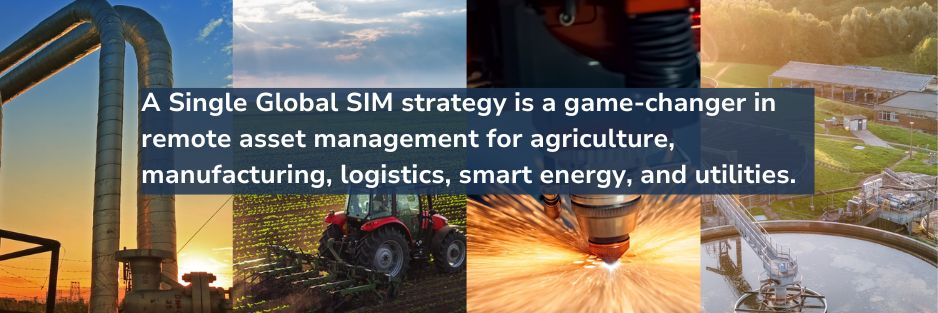
A One SIM strategy is a game-changer in remote asset management for agriculture, manufacturing, logistics, smart energy, and utilities.
Transforming Vulnerable VPNs with Zero Trust Security in 2025 is Sound Cyber Strategy
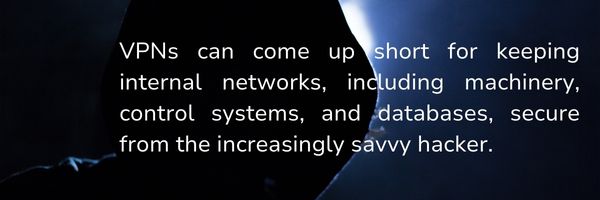
As the world becomes more connected and cyber villains get smarter, networks for remote operators are fair game to threats and cyber risks. Chief Technology Officers (CTOs), Chief Information Officers (CIOs), and Chief Information Security Officers (CISOs) are tasked to protect data, people, and reputations. Here, we explore why VPNs come up short while zero trust puts you ahead. CTOs, CIOs, and CISOs, you are the cyber watchdogs of your organizations, so this message is for you. In a previous blog written for C-suite leaders, we established that VPNs can come up short for keeping internal networks, including machinery, control systems, and databases, secure from the increasingly savvy hacker. Why does this matter? When we talk about the internet of things (IoT) today, everything is connected to the internet, from your watch or phone to thousands of business assets like machinery, sensors, and industrial equipment. With only a VPN standing guard, a hacker can get into your network through your facility’s smart thermostat (lest we forget the casino fish tank data hack of 2017). For decades, FreeWave has provided industrial IoT solutions for companies in oil and gas, agriculture, mining, water treatment, and other remote industries, to help them overcome a variety of network productivity issues and give them peace of mind that the health of their network – and the assets connected to it – is robust and secure. We believe, whether it’s working with our channel partners or adding our equipment to an OEM’s solution, that there are four essential security outcomes companies investing in IIoT should strive for: Secure remote monitoring and data management Automated, decisive response to threats No to low network vulnerabilities Cost savings compared to traditional VPN-based security Decommissioning a VPN as a primary source of cybersecurity in favor of zero trust network access (ZTNA) creates a stealthier, easier-to-use framework to detect and deflect cyber-attacks. Cybersecurity in the Wild West It is widely understood that Europe has continuously been five to 10 years ahead of the United States when it comes to cybersecurity. This is because the United States is like the freewheeling wild west. Cyber attacks cost companies billions of dollars. In IBM’s Cost of a Data Breach report for 2024, companies averaged a loss of $4.88 million, which is a 10% increase over 2023. More specifically to VPNs, the 2024 ThreatLabz VPN Risk Report published by Zscaler says that 78% of organizations plan to implement a zero trust strategy in the next 12 months with 91% of respondents concerned that VPNs will lead to a “compromising breach.” The survey says top threats to VPN vulnerabilities are ransomware (42%), other types of malware (35%), and DDoS (distributed denial-of-service which are attempts to overwhelm a server or network) attacks (30%). The findings make sense. Let’s say you notice nefarious traffic going across your network and you realize it is a former employee who still has access because their VPN credentials were not completely shut off. Even after you took their computer, they were able to go to their own computer, fire up a VPN and use their credentials to get into your network. VPNs are like a house – once you’re in, you’re in. Now you are faced with spending valuable time dealing with this behavior and any resulting damage. In contrast, a zero trust network promptly and fully blocks attackers from any access in the first place, making your job of monitoring considerably easier. As a tech leader, imagine what that level of security could do for your peace of mind as well as your company’s risk landscape. Zero trust is not new, but it has evolved. It was first coined in 2010 to protect enterprise networks, cloud networks, and basic IT networks. Two obstacles to zero trust are based on dangerous assumptions. One is that, while cyber attacks happen every day, they won’t happen to you. The other is that upgrading to ZTNA is too costly. If you’d like to explore why both are myths, give us a holler. To protect your data and network, start exploring the lowest level of your system and work from there. These questions are a good start to finding and closing vulnerabilities. What are your highest priority assets to protect? How will you handle encryption across diverse environments? Are you buying devices designed to implement zero trust? Are you buying network routers that are better suited for zero trust enablement? Are you developing edge networks with zero trust architecture to prevent people from plugging into an ethernet port on your network and destroying the site? What would be the potential harm to the business if your data and network were compromised? If you don’t have answers to all these questions, take heart. FreeWave has the capacity to interface with companies on their third-party applications that are not zero trust enabled. We manage this through what we call a “demilitarization zone,” where we have an unsecure system and a secure system and we match them together and know that the unsecure system is authenticated. We set up the entire network to avoid potential threats. Many remote, industrial operations have multiple locations to manage. A company with 10,000 sites – what we call the Razor’s Edge© where the data lives – would otherwise have to send its IT techs out to every site to implement a security platform. That means work, time, and expense. FreeWave is simplifying IIoT data by developing an easier pathway to zero trust on edge networks. Imagine sending a zero trust enabled device out to each site, installed on a network in minutes, while protecting said network down to the desired granular level. In the world of devices, the idea that a device can be designed and manufactured so that it is zero trust secured as it comes off the production line has been getting a lot of traction over the last five years. This approach is miles ahead compared to when VPNs were first introduced. You can always tap into FreeWave’s
Why Choosing Zero Trust Network Access Over Virtual Private Networks is a C-Suite Decision

You’re leading the company. Why do you need to care about your business’ network security approach? The answer comes from something all too familiar: the accelerated rate of change – and the quest by modern leaders to build a resilient company. PwC describes today as the “age of continuous reinvention” in its 27th Annual Global CEO Survey report. One of the most startling findings is that 45% of CEOs do not believe their company will be viable in 10 years if it stays on the current path. Part of the challenge is knowing what could take your company down. Cybersecurity vulnerabilities at the network level is on the list. PwC’s report shows that CEOs who believe their organization is viable for more than 10 years perceive inflation (21%) and cyber risks (21%) as top threats with macroeconomic volatility (20%) just a half-step behind. As chief technology officer for FreeWave, part of my role is to find weak spots in a network connected to the industrial internet of things (IIoT). I talk to many senior leaders from companies in the oil and gas, agriculture, mining, water treatment and other remote industries. What’s the number one pushback I run into? They tell me they use virtual private networks (VPNs). I call this “pushback” because, at FreeWave, we don’t let VPNs into our data platform. At their most basic level, VPNs are used to create a secure connection between a user’s device and the VPN server. Through that connection, data is encrypted, and a user’s IP address is hidden. As a result, VPNs can allow remote users to securely access internal networks, including machinery, control systems, and databases. For those who may not be familiar with a VPN (although we’ve all probably used one at some point), here’s a simple analogy. Think of a VPN as a tunnel buried far below intersecting highways. One end of the tunnel is an IIoT device and the other end is the server. Your car (let’s make it a Maserati, while we’re at it) is a data packet. Instead of traveling across potentially dangerous highways where threats abound (a malicious attempt to steal your Italian beauty and hold it for ransom, as an example), you take the tunnel built just for you and other authorized drivers you trust. The challenge today is that the tunnel is no longer safe. Why Are VPNs Insecure? Technology ages faster than a male tsetse fly. Our tiny-winged friends hit their teenage years by week two or so. In contrast, technology ages by the nanosecond. I think the reason why many people use VPNs is the same reason hackers infiltrate them so easily. VPNs are old technology. They have long been the go-to solution for providing remote access to industrial control systems (ICS) and other critical infrastructure. They were born during the rise of the internet late last century. One solution begets other problems. The world wide web went from 3 million to 16 million users between 1990 and 1995 (today, there are 5.45 billion users, around 67% of the population). As a result, a group led by Microsoft sought a solution to growing security concerns. That’s how VPNs were born. To be fair, there are ways to make VPNs secure, but the enormous expense doesn’t make financial sense for most companies. Here are three reasons why VPNs cause concerns when protecting an IIoT network: VPNs have outdated authentication models. Username and a password is all you need. I can get into a VPN easily. VPNs are a single point of failure. If something goes wrong with the server, you can’t get in. If I’m a hacker, the best way to take down every remote access in the world is to take down the VPN server. VPNs are hard to monitor. The actual traffic on the network makes it hard to identify nefarious activity flying across it. Let’s say you have this machine on the edge (edge is simply the source of where your data is – this might be where oil is drilled in upstream oil and gas, for example). The data is being processed on that machine (edge computing) and is connected to the corporate network via a VPN. A disgruntled employee leaving the company can sit in their car and use their username and password to access the device through a cellular system. What is the potential damage? In 2020, several prominent VPNs experienced critical vulnerabilities that allowed attackers to bypass encryption and access systems. The Colonial Pipeline attack, for example, was traced back to a legacy VPN, according to then CEO Joseph Blount. The East Coast company paid hackers $4.4 million to restore service quickly. VPNs create easy targets. Once you’re in, you have free rein to do what you want. Solving the Challenge to Scale Network Security A report by McKinsey and Company predicts 50 billion devices will be connected to the IIoT by 2025. The pace of change, according to the report, has increased tenfold. This means the risks and insecurities behind VPNs for organizations, especially remote industrial leaders, are rising. I talked to a large agricultural company recently that uses a VPN. Here’s how the conversation went: Them: How can we add 20,000 sites to our system? Me: We’d have to add 20,000 VPNs. Them: Wait, what? Me: It’s really difficult. VPNs are hard to scale. One VPN is one thing, but many VPNs are a nightmare. We believe a better way to secure a network is to use Zero Trust Network Access (ZTNA). ZTNA creates a network fabric using the principle of least privilege access (PoLP). The premise: trust no one. Each user accesses only the data they need. See how the lens flips from inside out to outside in? In a ZTNA, each user has a policy. This means they are authenticated for access to specific areas. The disgruntled employee mentioned earlier? They cannot go anywhere in the fabric without authorization. Even better, that user’s access can be easily removed or revoked. Ever
The #1 Strategy Remote Industrial Operators Need to Win the AI Race

From the inaugural Olympics in 776 B.C. until today, one thing has remained the same: athletes bring gritty, physical prowess to their chosen sport – and the human desire for excellence. Of course, other things like culture, fashion, and technology have changed dramatically (thankfully, since athletes in the first Olympics competed naked!). In the Olympic Games Paris 2024, one game changer is the role of artificial intelligence (AI). Remote industrial operators looking to scale business value and improve decision-making through edge data, take note: the Olympics, watched by 3 billion people from around the world, is deploying AI to improve future performance of their event. According to an article published by the International Olympic Committee (IOC), AI and digital twinning are being used as an efficiency booster for future Olympic games – from energy consumption to identifying the best places to place cameras and power sources. “The expectation for a lot of people is ‘I’ll just AI it.’ It’s like a magic wand.” One thing AI demands is historical data. This is why we are so passionate about industrial operators owning their data. Without data ownership, it’s a false start when using large language models to train and leverage AI algorithms. In the article entitled “AI and Tech Innovations at Paris 2024: A Game Changer in Sport,” Ilario Corna, the IOC’s chief technology officer said, “We started gathering various operational data as far back as 2020, to look at how we can make the management of the Olympic Games more efficient.” Ryan Treece, global business development manager – data platform & AI solutions at FreeWave, has seen AI evolve over the past decade. He says companies that don’t give customers rights to their data are putting them at a disadvantage. “The thing is that those who own their data will eventually win because they can use it while others will start from zero.” Catching up over time, he points out, becomes increasingly difficult as competitors advance. Companies that secure data ownership today are the ones who will lead tomorrow or, in Olympic terms, will earn gold in the AI race. That’s one reason FreeWave drafted the IIoT Bill of Rights (data governance is amendment one) – as a way for remote industrial operators to leverage technology for future growth and opportunities. Importance of Data Ownership in the Age of AI Owning your data is not just a competitive advantage; it’s a necessity. “There are a lot of AI solution providers,” Ryan explains. “The expectation for a lot of people is ‘I’ll just AI it.’ It’s like a magic wand. Look into the future, though, and ask: What do vendors like? Reliance on their systems.” Ryan says there is no one “mega-solution” out there to solve every problem, but, if there’s one thing he hopes industrial operators know it’s that data ownership means leveraging your data for operational and business performance. “We’re targeting predictive maintenance to prevent machines from going down, reduce fuel waste just to see if a machine is running dozens or even hundreds of miles away, and increase efficiencies so people are not wasting time and energy resources. Data creates long-time success.” Just as the IOC is using AI to create more efficiency in the future, he says understanding data over time enables industrial operators to continuously improve. While still under development, FreeWave is building its AI solutions around domain expertise. Through its FreeWave® Insights™ data platform, it’s connecting decision-makers with data at the edge via sensor technology, pulling in SCADA system data as well. He cites vibration tension sensors as an example. If a rotating asset like a bearing, for example, wobbles, an alert is sent to a single pane of glass – a dashboard connected to the Insights data platform. From there, a technician can add the issue to his planning schedule. Ryan shares the story of when he lived in Michigan. An automotive manufacturer that made panels, a “tier one supplier” in the industry, didn’t have the budget to climate control the entire building. In hot, humid weather, the adhesive failed. Since variables change over time, he says, IIoT solved the problem. “Vibration and temperature data from sensors showed the numbers going up and down. Historical data tells us to change the adhesive or turn up the AC or ramp up the climate control when needed. The manufacturer and its solution providers knew what knobs to turn by identifying trends in a specific period.” That’s why, he says, data ownership is so important. Without data, AI becomes impossible. Solve – and Simplify – Operational Problems “We’re working on solutions that reduce the tech stack and address specific problems like predictive maintenance and trends analysis of sensor data,” said Ryan. “When I’m thinking data, I’m thinking of a huge Excel spreadsheet.” Real-time monitoring of temperature, vibration, or water levels, for example, are important variables for industrial leaders: oil and gas producers with fields in remote or rural areas, large-scale agricultural operations with water pump stations dotting thousands of acres, or public and municipal providers with aging infrastructure in need of robust, remote network strength. These are places, Ryan says, that pose a risk for people to perform daily or weekly monitoring. Ryan points to his hometown of Austin, Texas, where the energy grid is unreliable, especially during hurricane season or super hot summer months. The panels on the grid can overheat. Alerts notify engineers to replace components before problems start. Rather than react, alerts and predictive maintenance reduce downtime. Another example he gives is California where water is a precious commodity. Knowing humidity levels, soil moisture, and water consumption allows agriculturalists to invest minimal resources for better outcomes. AI, he says, optimizes sensor data locally, at the edge, by providing analyses crucial to decision-makers. Failure-Proofing Connectivity Keeps Data in Play Oftentimes, industrial operators don’t have ready access to cellular or Wi-Fi, however, satellite is an optimal solution for areas with questionable coverage and those wanting a strong back-up connection. Pairing satellite with the FreeWave cloud-based Insights platform-as-a-service
Industrial Operators – You Own Your Data and Then Some
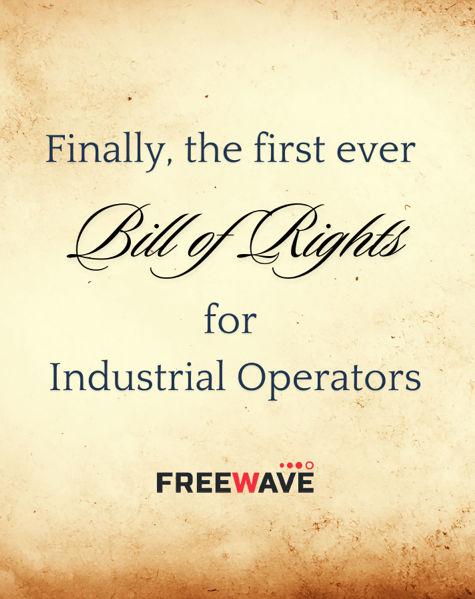
July here in the states is painted red, white, and blue. It’s a time when freedom becomes front and center. We are grateful for our young country. We remember the Founding Fathers and the sacrifices they made. We recognize, if only for a moment, our collective pride. No matter your country of origin, those who came before were brave enough to make a path toward a future with greater freedom. This got us thinking (after all, we do have “free” in our company name!). What does freedom mean when it comes to data? What does freedom mean for remote network industry leaders? Freedom means access to your data. Freedom means ownership of your data. Freedom means visualizing operations through real-time data. Data, in a sense, renders the freedom to take action, make informed decisions, and realize greater business value at scale. At FreeWave, we pledge to make IIoT data a freedom all remote industrial leaders can enjoy. Freedom gives way to growth, learning, and success. For more than 30 years, we have believed in the power of data. Data impacts decisions, business value, and, most importantly, the very future and safety of real people and our planet. Henceforth (to borrow from our Founding Fathers’ lingo), we’ve taken the liberty to create the first-ever industrial internet of things (IIoT) Bill of Rights. This is more than a list of nice-to-haves, they are must-haves for remote industrial operators of every size and industry. The IIoT Bill of Rights is our position on data governance and data democratization. It addresses global reach – that a remote industrial operator can be anywhere in the world and know what’s happening within their operations no matter how far they are spread out and what environmental conditions surround them. We believe a secure cloud environment is the right of every remote industrial leader. Zero Trust Security is not a privilege of a few, but the mainstay of many. Data should be kept safe, no questions asked. We also champion continuous connectivity. This comes by way of unlimited, high-speed, affordable satellite connectivity for all. To round our IIoT Bill of Rights, we lean into one of our four core values: Be a simplifier. This means that IIoT data solutions should be easy, plug-and-play deployments. No hair-pulling. No head-scratching. No unnecessary downtime. Instead: Open box. Power on. Get Data. This means fast deployment because uptime is one of the biggest freedoms IIoT data enables. Data inspires greater uptime because you have knowledge at your fingertips to make amazing decisions that keep operations running smoothly, all while keeping people safer. Another IIoT Bill of Rights amendment calls for cross-translation of protocols so that remote industrial companies can transform existing SCADA networks into data racetracks that carry more data, faster. Cross-translation allows different edge or SCADA protocols on the edge, SCADA, and even devices that speak different protocols to communicate. This is how industrial leaders can unleash the full power of an IIoT network infrastructure. The last amendment is AI readiness – because those who own their data will win the AI race. To see FreeWave’s full IIoT Bill of Rights, read our position paper. Working with our expert technical staff at FreeWave and experienced channel partners to solve your biggest wireless and edge computing challenges, you leverage the full solution for IoT connectivity that includes the FreeWave Insights™ data platform-as-a-service, satellite service connectivity (we’re a Connectivity Wholesale Partner in Viasat’s ELEVATE program), our portfolio of rugged connected devices, and satellite-connected devices (we’re a Global Authorized Reseller of ORBCOMM). If you’re passionate about bringing meaningful technology solutions to remote industrial companies, join us as a channel partner. If you’re a remote operator looking to scale business value leveraging your IIoT data, contact us here. We’re making a path to a future where data serves industrial operators in measurable and positive ways. Let’s do it together.
Latin America, Oil and the Race to Retrofit
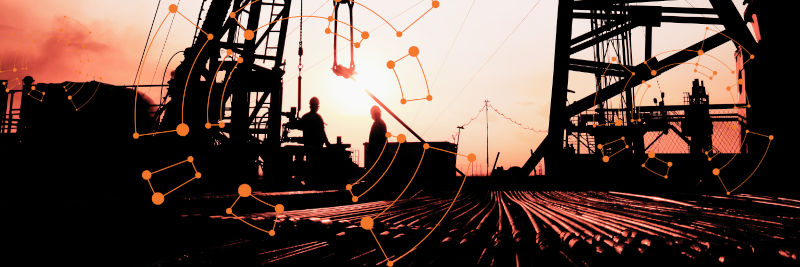
Latin America has the second-largest proven oil reserves in the world behind the Middle East, yet it’s never been known as an oil-producing maverick due to external and internal hindrances, including U.S. sanctions against Venezuela and a regulatory framework in Mexico and elsewhere that tends to dampen competition. All that is about to change. With geopolitical disruptions wracking the Middle East and Russia, importers looking to diversify their oil supply have set their sights on Latin America — and for good reason. The discovery less than a decade ago of around 11 billion barrels of crude oil reserves off the coast of Guyana made headlines globally, with news coverage reaching a fevered pitch when the oil started gushing into pipelines. The “incredibly short” five-year timespan between discovery in 2015 to full-blown production in 2020 was “unprecedented,” according to Oilprice.com. The discovery, and the oil-and-gas exploration since then, has huge implications for the global market and for Latin American oil producers. It offers a partial solution to a looming problem: a source of clean, cost-efficient oil, which will be in high demand during the decades-long energy evolution. To stay competitive and claim its stake as part of the solution, Latin America’s existing onshore oil fields, which historically operate well below their production potential, have shifted into high gear to optimize performance, increase operational efficiencies, and reduce greenhouse gas emissions. There is a challenge, however, faced by many existing producers: aging infrastructure. Data Within Reach Aging infrastructure located in harsh, remote environments like the Maracaibo Basin in Venezuela, which is surrounded by mountain ranges and an almost constant veil of overhanging clouds, or the Sureste Basin in Mexico where more than 50% of the basin area is located in a deep-water Campeche slope, are not be built for data at scale. The challenge of outdated infrastructure lies in leveraging data from the increasing number of sensors at the edge for data collection, storage, analysis, and connectivity across the enterprise. IIoT devices have long been MacGyvered with twine and duct tape. They use different protocols within decades-old SCADA systems. These disparate systems hurt production potential with two significant barriers: equipment from a variety of vendors along with little or no historical documentation to reveal who or what the modifications were and machine languages that don’t talk “nicely” to one another. While we don’t have statistics showing the number of aging pipeline networks in Latin America, there is evidence that outdated equipment reduces oil and gas opportunities. In early 2024, the U.S. Energy Information Administration looked at Venezuela’s energy landscape and found that “much of Venezuela’s crude oil production capacity and infrastructure have suffered from a decade-long lack of capital and regular maintenance.” Yet, replacing a network from scratch is costly – and unnecessary. Retrofitting existing infrastructure makes sense, leads to increasing business value from your operations, and funnels data to key decision-makers throughout the business (yes, even beyond the operations team – more on that in a bit). To support our worldwide network operator customers, we often team up with in-region trusted distribution and system integrator partners. This helps our customers experience the FreeWave difference – an end-to-end Industrial Internet of Things (IIoT) data solution – with local expertise and ongoing support. One project we’re working on is based in Peru. The infrastructure is more than 15 years old. Over the years, personnel have changed and there has been no consistent tracking of data and processes. All this has led to knowledge gaps, with questions like: What equipment do we have in the field? Where can we increase efficiency? What data do we have that we don’t access? How can data help us reduce costly downtime? What data do decision-makers in different parts of our business need? How can satellite connectivity improve uptime and data access? In established oil fields, a rise in IIoT sensors measuring things like temperature, pressure, and flow is generating massive amounts of data. But too often, data generated at the edge remains siloed, beyond the reach of decision-makers. Or, because IIoT devices have been MacGyvered with twine and duct tape and, therefore, use different protocols within decades-old SCADA systems, standard protocols simply don’t communicate well. Retrofitting aging SCADA infrastructure means leveraging data for better data management, transfer, analysis, and visualization. The solution integrates IIoT sensors, edge computing, cloud analysis for extensive processing of data from different sources, and satellite connectivity. First, though, comes the convergence conversation. Unpacking IT/OT Convergence for Better Decision-Making FreeWave’s end-to-end solution includes the FreeWave® Insights™ data platform, connected devices like our FreeWave Fusion™ platform for edge processing and connectivity, ORBCOMM’s feature-rich satellite terminals, and satellite service plans through our partnership with Viasat. The unmistakable trend we’re seeing from our work in Latin America and other regions is is Information Technology (IT) and Operational Technology (OT) convergence. In the past, these two areas were worlds apart – and it was understandable. Each had its own agenda. They didn’t play in the sandbox together. Today, they must and can. Oil producers racing to retrofit their infrastructure are recognizing that convergence is essential. In an article by McKinsey & Company, “While the rationale for converging IT and OT originated years ago, the emergence of IIoT is driving momentum today—particularly IIoT’s need for data from a vast number of sources. Compared with a traditional IT stack, the IIoT-based industrial automation stack adds a new layer for analytics, end-user digital applications, data management, and storage.” An operation and IT alliance amps up computational power in the cloud and gives a clearer insight to more users. FreeWave is closing the IT/OT gap for oil producers in Latin America that have aging infrastructure needing to get data from sensors and machines in the field, converting that data through our platform and delivering it via a single pane of glass – a user interface that provides uninterrupted visualization of data to real people, alerts, and alarms that enable data-driven decision at the point of decision-making. While technology has evolved, OT has always been
Satellite Connectivity Becomes Next-Generation Tech for Remote Operations
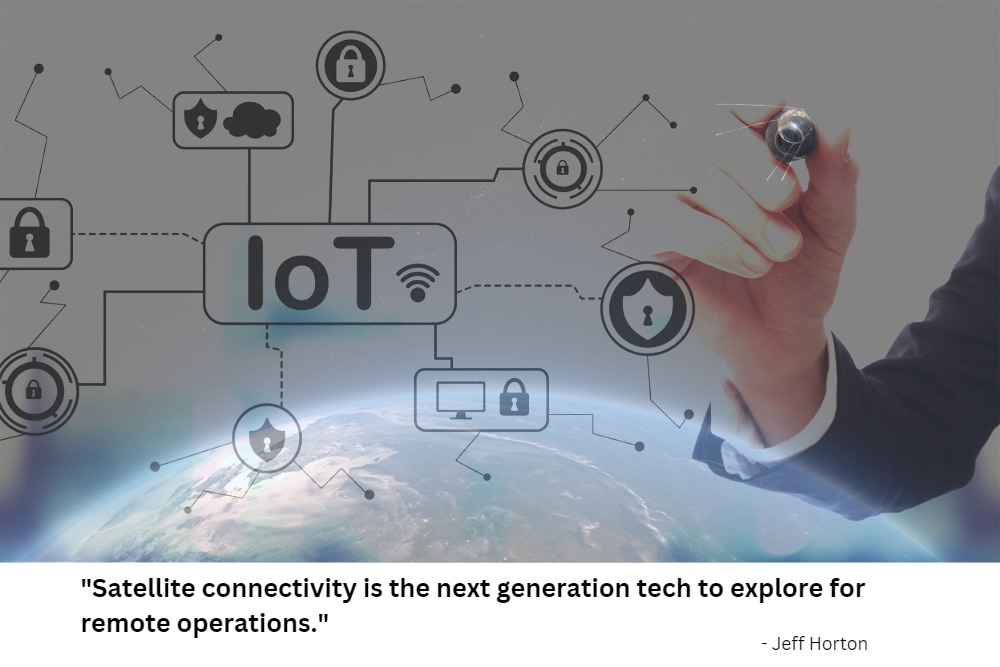
The future of IIoT connectivity is up in the air — literally. Space is the new frontier for IIoT connectivity, as satellite connectivity is fast becoming the networking solution of choice for many industrial use cases. IIoT, or the industrial internet of things, refers to an ever-expanding ecosystem of sensors, networking equipment, and analytics, which work together to collect, transmit, and analyze data from “things” used in industrial operations. Data transmissions from industrial assets help guide business decisions or automatically trigger actions. For example, in agriculture, IIoT-enabled irrigation systems monitor soil moisture levels, weather forecasts, and other data points to help growers determine the best time to water, or the IIoT solution can automatically activate sprinklers without human intervention if programmed to do so. When talking about satellite, this two-way communication reveals the next-generation tech for remote operations. First, though, let’s take a quick glance back. What Satellite Connectivity Means for People in Remote Areas FreeWave started by helping customers transmit mission-critical data using radio technology in 1993. We’ve seen the evolution of communications since then, with not only our rugged wireless radios continuing to serve the future of the oil and gas industry, but also the advancement of satellite for people leading remote operations. Traditionally, IIoT has mostly relied on cellular connectivity and other terrestrial solutions for data transmission, but as IIoT continues its push into underserved locations — from remote grazing pastures in Colorado to offshore oil platforms in the Pacific Ocean — cellular solutions pose some serious limitations. Connecting people, not things, is the foundational purpose of cellular infrastructure development, so in sparsely populated or remote areas, cellular service may be limited or even surprisingly unavailable. While other non-cellular connectivity solutions exist, for certain circumstances, satellite is becoming a more viable solution, offering distinct advantages. Competition is driving rapid innovation in the IIoT satellite space even as it drives down costs. As a result, companies that previously encountered lack-of-coverage or cost barriers with the various terrestrial networking options now have an affordable IIoT connectivity solution in the form of satellite — with cost savings between four and 20 times what they once might have paid. Satellite connections are, by definition, wireless and don’t require remote operators to install fixed lines — DSL lines or coaxial cable — for data transmission. This added flexibility gives companies the freedom to scale their IIoT applications quickly and easily as their needs and business goals evolve. For example, a major agriculture company with an expanding customer base in remote parts of Brazil, Argentina, and Chile announced it will use satellite connectivity to operate autonomously driven tractors in those countries. In these remote areas with no cellular or Wi-Fi coverage, real-time communication through satellite connectivity allows farmers to stop and start the tractors and other unmanned equipment, monitor the equipment’s performance, and determine what to do when a tractor encounters an obstacle — all through an app-based control panel from afar. Meet LEO and GEO Not all satellites are created equal, however. There are three common satellite types: Low Earth Orbit (LEO) satellites, Medium Earth Orbit (MEO) satellites, and Geostationary Equatorial Orbit (GEO) satellites. LEO and GEO represent the two altitudinal extremes and are most commonly used for IIoT connectivity. LEO satellites are smaller and orbit closer to the earth, so launching them is less expensive. LEO satellites circle the earth several times a day, so multiples are needed to fly in succession over the target geographic area in order to provide consistent coverage and avoid dataflow disruptions. The ground equipment needed to monitor and maintain LEO satellite constellations is also extensive. GEO satellites — a type of geosynchronous orbit (GSO) satellite — also orbit the earth, but they do so along the equator in the same direction and at the same rate the earth is spinning. Hence, from our vantage point, a GEO satellite looks like it’s standing still since it is always above the same location. Its daily orbit notwithstanding, a GEO satellite, for all intents and purposes, stays “parked” above the area that needs coverage. Since GEO satellites are continuously visible, ground station tracking is not required, and their greater height offers substantially more geographic coverage; in fact, only three GEO satellites can provide whole-earth coverage. LEO satellites and GEO satellites both have their place in IIoT connectivity. With less distance for signals to travel, LEO satellite solutions historically have offered lower latency rates and higher bandwidth capabilities, although newer GEO satellite solutions offer these capabilities now, as well, with a signal-bounce delay of about one-quarter of a second. The end user’s needs, business goals, and budget will determine which IIoT satellite solution is best. We’re seeing an increasing need for two key requirements for satellite connectivity — real-time or near real-time data transmission and two-way communications. Can Satellite Connectivity for Remote Operations Minimize the Impact of Catastrophes? Environmental catastrophes happen more frequently than we are even aware. Being able to positively impact a critical issue before it happens is certainly the goal of many. IIoT and its network-connected sensors and dataflow provides the catalyst for alarming and alerting to help alleviate the impacts of disastrous situations whether they be natural phenomenon, human error, or otherwise created. FreeWave has expanded our footprint in the environmental space, helping customers deploy early-detection IIoT sensors that alert the appropriate personnel in the event of a disaster. Let’s take the case of a timber company using sensors to detect lightning strikes or approaching wildfires. Strategically placed sensors are programmed to detect various gas profiles indicative of those events. A delayed alert could spell disaster, so real-time notifications are of paramount importance. The same is true for oil and gas companies that receive alerts before a catastrophic equipment malfunction—real-time alerts to what’s happening in the field could save millions of dollars and prevent environmental devastation and other ramifications. One-way and Two-way Satellite Communications In many use cases, two-way communication is needed to optimize industrial operations. Some IIoT connectivity solutions only transmit data one way, from the
FreeWave’s Steve Wulchin Returns as CEO
On January 9, 2023, Steve Wulchin returned as CEO of FreeWave Technologies. Steve served as the company’s CEO from founding — as one of its co-founders —until 2014. An experienced business leader, Wulchin will succeed Kirk Byles and assume responsibilities immediately. Mr. Byles has left the company to pursue other opportunities. As the chairman, co-founder, and former CEO of FreeWave, Steve has been intimately involved since its inception three decades ago. Steve’s vision has always been to create a great company with great products and amazing people who are driven to provide superior solutions and service to our customers. “Steve’s leadership will propel FreeWave forward into the vision set for its IoT-enabled success and next phase of growth.” said Bob Dimicco, FreeWave board member. Wulchin holds an MBA from the University of Texas and a BS in Commerce from the University of Virginia. His passion for both the wireless industry and FreeWave’s evolution as an intelligent edge solutions provider played a pivotal role in the company’s success to date. “FreeWave is uniquely positioned to take advantage of the cloud-enabled data opportunities available in the IoT space.” said Nazila Alasti, board member. “With Steve at the helm I’m excited to see what the team can do to bring that vision to fruition.”
2023 and Beyond: A Visionary Q&A with FreeWave
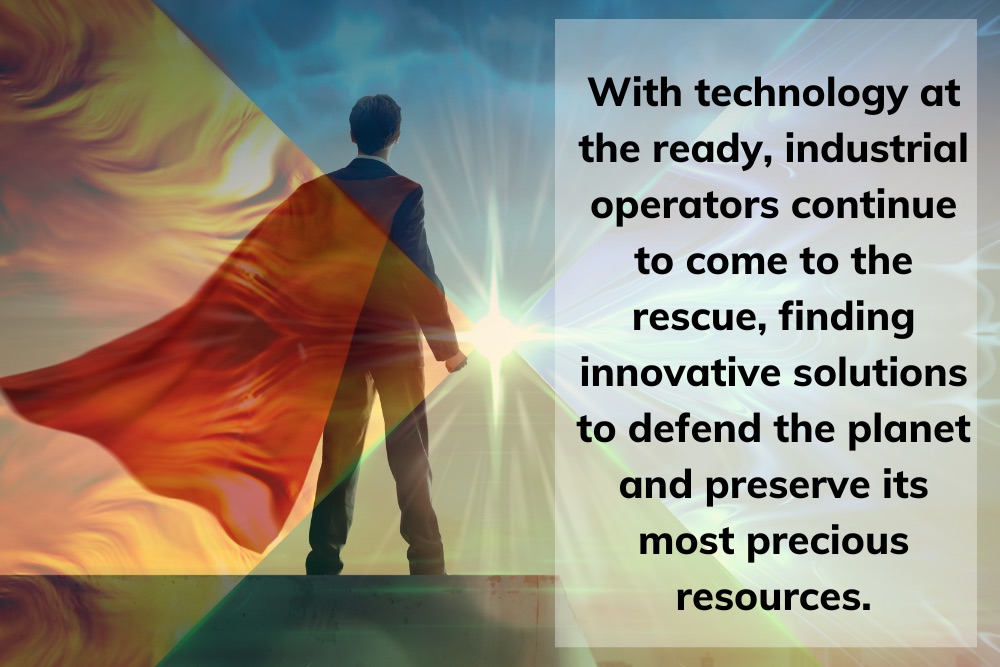
With fresh insight and excitement for the year ahead, the FreeWave leadership team discusses their vision for the future, predictions about the evolution of data, and collective approach to protecting life’s essentials. Though you might not find their names in the next Marvel film or DC comic book, industrial leaders – whether in agriculture, energy, utilities, or another resource industry – are the heroes of the modern world, real-life Guardians of the Galaxy, if you will. These heroes fight today’s challenges every day, while life’s essentials like food, air, energy, and water are threatened daily. With technology at the ready, industrial operators continue to come to the rescue, finding innovative solutions to defend the planet and preserve its most precious resources. At FreeWave, our goal is to continually build upon technology advancements to help you build a better world within your industry. With 2023 right around the corner, we asked four of FreeWave’s senior leaders, including Kirk Byles (CEO), Michael Tate (COO), Parthesh Shastri (CTO), and Jeff Horton (CRO) to share their thoughts on how FreeWave Technologies is helping the heroes of today protect life’s essentials to create a better tomorrow. ___________________________________________________________________ Q: What is one of your favorite FreeWave memories from this past year? Kirk Byles: It’s hard to even remember before this quarter, but the Reinke Dealer Conference was definitely a top highlight for me this year. Not only did it show the work our collective teams have been doing to build relationships and finalize a new product offering, but it was also really cool to see the impact our work is having in real-time, as we partner with Reinke – one of the largest pivot irrigation manufacturers in the world – to help growers and producers save water and raise crops. This was really big. Parthesh Shastri: This year, we really came together across disciplines within FreeWave, too, increasing our focus on target outcomes to deliver products that our customers use and deploy in the field, and we had a lot of fun while doing it! As we look at 2023, we are excited to scale this model and implement it across new industries. Q: How is FreeWave helping industrial operators protect life’s essentials? Jeff Horton: The top thing that comes to my mind is bringing automation to irrigation. We work closely with our partners, like Reinke, to provide real-time analytics, which saves a lot of water and nutrients, and both of these things are invaluable for farmers. Technology also helps to reduce fuel consumption on ranches by eliminating the need to manually check cattle watering tanks. Some producers often spend 12 to 15 hours a week driving around just to look at their water tanks. Think about the wear and tear on those pickup trucks or even the rising cost of fuel. Being able to reduce greenhouse gas and save these guys money while also producing a high return on investment is a really big deal. We can do that easily with the Tank Level Monitor. Mike Tate: And it’s not just the ROI. These producers are suffering. Ranching is not the lucrative business that it once was, and these ranchers are getting beaten at every turn. A lactating cow needs one gallon of water for every hundred pounds, every six hours! Water is a huge concern for both producers and growers, and being able to give them back more time while reducing their expenses is a great value add because every dollar counts for them. Q: Is the word “efficiency” changing for industrial operators? Jeff: When you look at conditions today, both here in the United States and globally, you see so many labor shortages, droughts, inflation, and climate changes, and it’s forcing efficiency, not for efficiency’s sake, but for sustainability and survivability. Businesses have to fundamentally change the way they produce a product, and they have to find the least expensive, most efficient path to go to market. Efficiency isn’t an option anymore; it’s a necessity. Kirk: For years, everybody has wanted to do more with less, and usually, there’s some sort of limitation in the way until someone invents a solution that takes things to the next level. That’s what we’re all about at FreeWave. We’re not doing anything necessarily earth-shattering; but we are innovating. We’re providing a mechanism for our customers to become more and more operationally efficient – to increase their bottom line – and make things better, and not just for their business, but for their employees and life, in general. Case in point: oil and gas companies, considered by some to be big polluters. However, these companies have many sustainability and environmental initiatives and tenants they strive to uphold. They are a critical component of our everyday lives. They’re evolving and innovating, too. FreeWave, helps them get the most out of the equipment they have on-site so that they’re more effectively getting the oil and gas out of the ground with minimal impact. Overall, a more efficient company means less impact on the environment, and these kinds of solutions help create a better planet. Q: In your wildest imagination, where can technology take the industrial leader in the next ten years? Parthesh: There are so many great examples. In China, there’s currently a 12-story tall facility being built to raise hogs in a conditioned environment. It’s like an office space for swine. In this environment, technology is being used in such a way that human intervention is really minimized, and because most things are entirely data-driven, they are able to be a lot more efficient. Now, there are pros and cons to what’s taking place there, and we won’t know the final outcomes for a while, but the march of technology is going to continue to go on, and I believe we will continue to see a lot more practices like this in the future. Jeff: Another example is indoor growing facilities in Saudi Arabia and Qatar. Massive facilities that are purpose-built for farming simply because there is
Ranch Life: Water Visibility is Critical Part 2
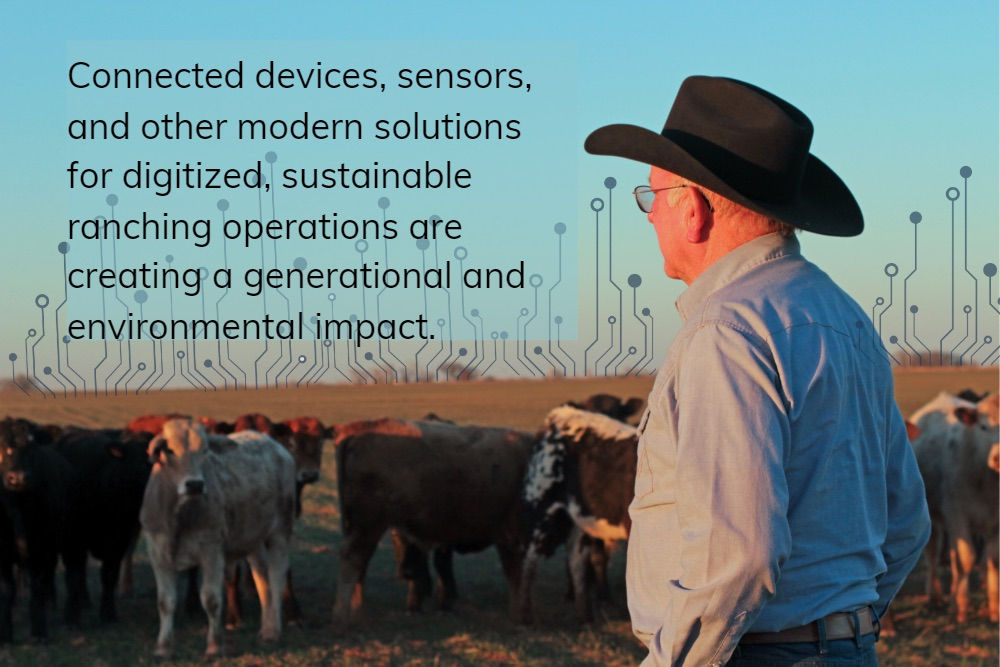
Measurement is part of a farmer’s DNA. It improves plant yields, herd health, resource conservation and impacts the bottom line – from ensuring livestock reach their peak for maximum prices at auction to guarding against overgrazed pastures. Observation and measurement, especially for the stewards of our land, determines performance in many categories of a ranch’s operations. In Part 1 of this series, we explored how the metrics of today and those of the original homesteaders varies in one significant way: technology. A quick recap: The Internet of Things (of the ranch) or IoT is like having an extra set of “eyes and ears” spread across the ranch. In short, connected devices are bringing near real-time visibility into what is happening in disparate parts of the ranch. How do all those devices spread across thousands of acres bring value? Here are five scenarios modern ranchers are using to transform their operations. Scenario One: Instead of rolling out trucks to check water usage in stock tanks, ranchers are saving time using alerts or checking tank levels on their devices Tank level and creek/river monitoring solutions (FreeWave Water Level Monitor) help ranchers manage water usage better. In the past, and to some effect still today, farmers and ranchers don’t know how much water they use. Inexpensive and simple-to-deploy sensors in tanks, aquifers, springs, and pumps allow ranchers to know exactly what is happening with water usage and make intelligent decisions about watering pastureland and hayfields, filling tanks, and moving water. (click here for a special price offer for a limited time) Ranchers are in the “driver’s seat” (without ever leaving their chair) by setting parameters – thresholds like water levels or flow. Technology can seem complicated to many of us sometimes, but the IoT devices we are talking about are not. Drop-in remote sensors simply plug in so ranchers can see what’s happening, in near real-time, rather than driving across thousands of acres in a gator to check hundreds of troughs and water supplies. Ranchers can easily monitor water levels in tanks 24/7 without routine in-person maintenance checks. (Bonus: there are no set-up fees with our solution.) Scenario Two: Paperwork is easier and faster using real data. Less manual inspections mean safer working conditions and less vehicle costs A digital ranch goes beyond automatic water distribution; it also includes insight and access to data metrics to help monitor and stay within local water use regulations. Ranching operations require lots of paperwork, especially those using public lands for grazing. For irrigation systems that take water from a natural resource such as an on-farm stream or river, data helps ranchers measure water availability and flow. By rolling out fewer trucks to check on stock tanks, there’s less wear and tear on trucks and less man-hours dedicated to manual inspections. Scenario Three: Soil moisture level monitoring improves grazing health Not only can digital solutions enhance the quality of water production on a ranch, but they can also play a role in helping to visualize and maintain the quality of the soil for high quality grass for grazing. Sensors determine soil moisture levels and overall health from the air. Better soil means a better ranch, and a better ranch means healthier land, livestock, and profitability. With near real-time data in hand, ranchers can make more informed decisions – just like they always have through observation and measurement – about soil behavior. For example, knowing actual soil moisture levels influence when to rotate cattle on different fields so ranchers can fertilize the land, continually giving fresh grass for the cattle to munch on. Scenario Four: Preparing for adverse weather A string of hot days, the possibility of wildfires, and water scarcity along the Great Plains changes the game for ranchers. No one can control the weather, but technology can help ranchers prepare. Virtual visibility into the surrounding climate of a ranch utilizes timely data to prepare and respond to natural weather updates and climate changes like wildfires, wind erosion, or soil erosion that might threaten ranchland management. Good decision-making and preparedness reduce energy costs and environmental impact. Scenario Five: Carbon dioxide detection is no longer a guessing game Last, but certainly not least, carbon dioxide detection is a game-changing tool for today’s rancher. With the right sensors in place, you can both manage your carbon dioxide emissions and monitor your CO2 levels to ensure better, more drought-resistant soil, which will ultimately aid in the sustainability of water conservation practices. With technology being the “ears and eyes” of the rancher, less money is spent on diesel and, as previously mentioned, wear and tear on trucks rolling out to different sites. The Road to Lean and Mean For those tending vast, open, and oftentimes remote expanses of land, FreeWave’s simple-to-use solutions are turnkey. These modern solutions for digitalized, sustainable ranching operations are creating a generational and environmental impact. They are up and running within 10 minutes or so. Using just about any device – cell phone, tablet, laptop, or desktop computer – ranchers see a dashboard, or what we like to call a single pane of glass. It sounds almost crazy, but FreeWave technology can work in virtually any environment, no matter how remote. Like many customers we serve, we put in our time to hone our craft: we started 30 years ago as a U.S. manufacturer of mission-critical wireless data radios operating in the harshest and most dangerous places for the military. FreeWave has created low-cost ranch coverage solutions to monitor stock tanks, water troughs, rivers, dams and other water supplies in areas with limited or no cell coverage using a variety of solutions, including satellite, cellular, Wi-Fi, Bluetooth, and more. Contact us to learn how you can get valuable time and money back from your ranch operations.



